Lens Test - the Chandlor 95mm f/2 for EOS mount
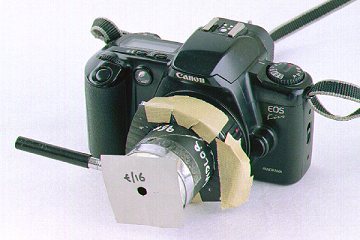 The Chandlor 95mm lens mounted on a Canon EOS "Kiss" camera (with f/16 stop) |
At a low point in life, photographically speaking, I bought a bottom-end Canon EOS SLR body (no problem there), but allowed myself to be persuaded to have the "standard" lens that comes in the "set" - the Canon 28 - 80 mm cheap-n-crappy zoom. It really is fairly awful, and I'm always advising people to get the (even cheaper!) 50mm f/1.8 lens, optically beautiful, just like the lens that "came with" a Canon A-1 in 1982. Anyway, annoyed at other people making comments like "pretty good optically", it occurred to me to ask if anything could actually be worse? The magnifying glass that's been kicking around in my desk drawer for years, for example? You can probably buy one in the 100-yen shop now.
A little more thought, in an idle moment, and I realised it would be fun to see just what such a lens can do. After all, the Canon zoom can provide reasonable images if stopped down to about f/16, so perhaps it's just a question of aperture. With about twenty minutes' work, there I was: the Chandlor 95mm lens for Canon EOS mount. The mount would be rather hard to make from scratch, so I started with a Kenko 20mm extension tube that I wasn't using for the moment. (If you don't have anything like that to spare, of course, you can buy a body cap for a pocketful of change.)
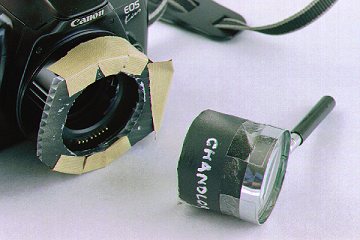 The focusing mount detached |
The photo on the left shows the construction. Before I started, I had already measured the focal length of the lens, so I knew roughly what length bits would need to be. First I found a piece of cardboard tube (the core from some kitchen towel) that fits inside the rim of the magnifying glass, and cut it roughly to length. Then I cut a circle in a bit of corrugated plastic sheeting to accept the cardboard tube, cut it to fit the extension tube, and taped it in place. (I used fabric "carpet tape", because although it looks fearsome, it peels off plastic without too much mess.) The tube is a nice fit, and slides in and out for focus. Unfortunately, with this arrangement the lens doesn't focus very close, because the movement is restricted to the depth on the inside of the extension tube to the plate with the contacts and stuff. I think I will re-engineer it on a body cap (300 yen, actually, I discovered), with two cardboard tubes, and more focusing range. Oh, I also made the stops - one f/5.6 and one f/16 - from pieces of paper sellotaped to very short bits of the cardboard tube. They fit neatly into the front of the magnifying glass (and stay there, as long as you don't point the camera downwards). Finally, I sprayed everything with some matte black paint I had left over from making props for Carmen in May.
Using an SLR body makes things like this so easy, of course. No big worries about light leaks. Actually there was quite a lot of light leaking in where the spring pin sticks out of the mount, and was pushing the corrugated board away from the mount flange. I've cut a slot for it now, but in any case, light only gets a chance to reach the film while the focal-plane shutter is open, so it's easily outvoted by the main image. Of course the EOS body says: "Uh-oh, don't know what lens this is. Can't autofocus, can't adjust the aperture..." But this doesn't matter: it shows the aperture as "00" and assumes the same amount of light will be coming in when the shutter opens. So the built-in metering works as usual.
The tests
I loaded my little Kiss with a roll of nice slow Neopan F (ISO 32) black-and-white film, put the tripod on the back of my bicycle, and went in search of appropriate subjects. Here's a comparison of images taken at Myoujin-sama, just down the road. The tripod position is the same, and so the zoom produces a slightly wider-angle view.
Chandlor 95mm f/2 |
Canon 28-80mm at 80mm max. f/5.6 |
|---|---|
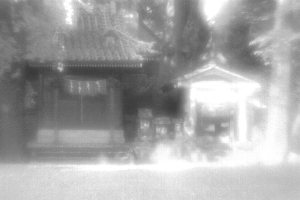
1/45 sec. f/2 |

Not available! |
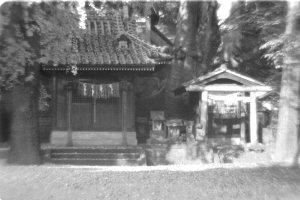
1/15 sec. f/5.6 |
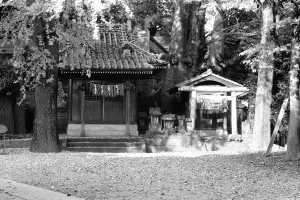
1/6 sec. f/5.6 |
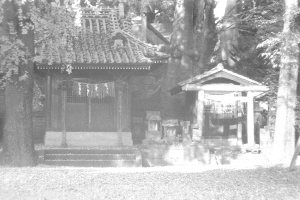
1.5 sec. f/16 |

1.5 sec. f/16 |
Oh, yes, I cheated: both zoom images are the same. I used the one taken at f/16 for both examples. Here's the real one at f/5.6 for comparison, but there's no obvious difference at this size. (Could this be the difference a tripod makes?)
Well, at f/2 the Chandlor 95mm is better, I suppose, since it produces an image. Not a terribly good image - there's more flare than anything else. By f/5.6 we can compare the lenses, and well, yes, we would have to say that the zoom gives a sharper and more contrasty image. Note that the automatic metering gives different exposures in this case - I didn't calibrate the f/5.6 stop very carefully.
And at f/16? Both lenses provide nice detail, though again the zoom has much more contrast. Almost too much. I find the low-contrast Chandlor has a wonderful old-world charm of its own, and while it's possible to increase the contrast in an image editor, I'm not sure it's an improvement. The negatives of the Chandlor images are quite obviously of reduced contrast, so this isn't a scanning problem; I suppose that the ordinary glass used simply has very high dispersion characteristics.
Value for money? My outlay on materials was zero, but assuming you have to buy a body cap, and a cheap magnifying glass, the Chandlor will still be less than 1/20 the price of the zoom. Well worth it!
More pictures of Sano taken with this lens